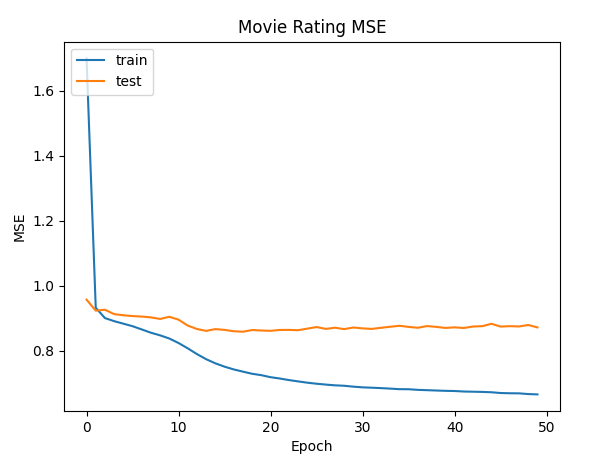- Course: Unsupervised Learning
- Homework 3
- Due Wednesday, August 4 at 6pm.
Problem 1 Work collaboratively with your classmates to come-up with the best performing movie recommendation system we can.
Based on MovieLens_MatrixFactorization_Keras_7.py
- Try different things that may improve the overall recommendation results. For example:
- Different neural network topologies
- Different regularization types
- Different optimizer settings
- Use more / less side-info columns
Do not limit yourself to these ideas. You are encouraged to try anything that you think could be useful
-
Collaborate with the rest of the class on this effort:
- Post your changes that seem to improve things for you
- Try and validate the changes that other people post
- You should give credit to the author of the improvements (a note in the code and in the report document)
- We will create a Teams group chat for this purpose
-
At the end of the week, you should submit code that performs as well as the best published (and validated) results in the chat.
- You will be graded on:
- How well your final solution works, relative to the best published solution
- 60 = equal to the best published solution
- Your positive contributions to the joint effort (new contributions + validations)
- 5 points per positive contribution
- You will lose points if you:
- Submit a solution that is inferior to the best published
- Keep improvements to yourself, without sharing them
- Not citing the contributions of others that you adopted
- How well your final solution works, relative to the best published solution
- You will be graded on:
- Thinkpad t14s
- CPU: AMD 4750u PRO
- iGPU: Vega 8 Renoir
- RAM: 16GB
Package Version
- imbalanced-learn 0.8.0
- imblearn 0.0
- keras-nightly 2.5.0.dev2021032900
- Keras-Preprocessing 1.1.2
- matplotlib 3.4.2
- numpy 1.19.5
- pandas 1.2.5
- pip 20.3.4
- scikit-image 0.18.2
- scikit-learn 0.24.2
- scipy 1.7.0
- seaborn 0.11.1
- tensorboard-data-server 0.6.1
- tensorboard-plugin-wit 1.8.0
- tensorflow 2.5.0
- tensorflow-estimator 2.5.0
- termcolor 1.1.0
- xgboost 1.4.2
 * Run 1: Execution time: 313.5 Best Test RMSE: 0.8963 at epoch: 53
* Run 1: Execution time: 313.5 Best Test RMSE: 0.8963 at epoch: 53
-
Run 2: Execution time: 315.9 Best Test RMSE: 0.8949 at epoch: 71
-
Run 3: Execution time: 319.5 Best Test RMSE: 0.8938 at epoch: 78
-
Execution time: 280.7
-
Best Test RMSE: 0.9266 at epoch 17
Parameters:
- Factorizing into 50 latent factors
- With 200 hidden nodes
- Dropout rate first layers: 0.6
- Dropout rate second layers: 0
- Max-Norm max value: 6
- Using activation function: LeakyReLU
- Optimizer: Adagrad. Learning rate=0.03
- Using Num epochs: 100 Batch size: 160
- Run 1: Execution time: 328.0 Best Test RMSE: 0.8941 at epoch: 98
- Run 2: Execution time: 326.9 Best Test RMSE: 0.8933 at epoch: 99
- Run 3: Execution time: 322.8 Best Test RMSE: 0.8947 at epoch: 71
Experiments with hidden nodes and latents factors
From professor Rojas:
After this collectives experiments we determinate that 50 hidden nodes and 50 latent factor are optimal for this exercise
- Dr Rojas
- dianaponcefaerron17
- michael.cw02
- chrisajivi88
- suscalder
- sergiosmcr
- Rafael C
- Deykel
- alcofo2191
- mriosm1992
- mariobg97
- cjv88
- eduardo.rojasr
Unsupervised Learning Class 2021!!!

